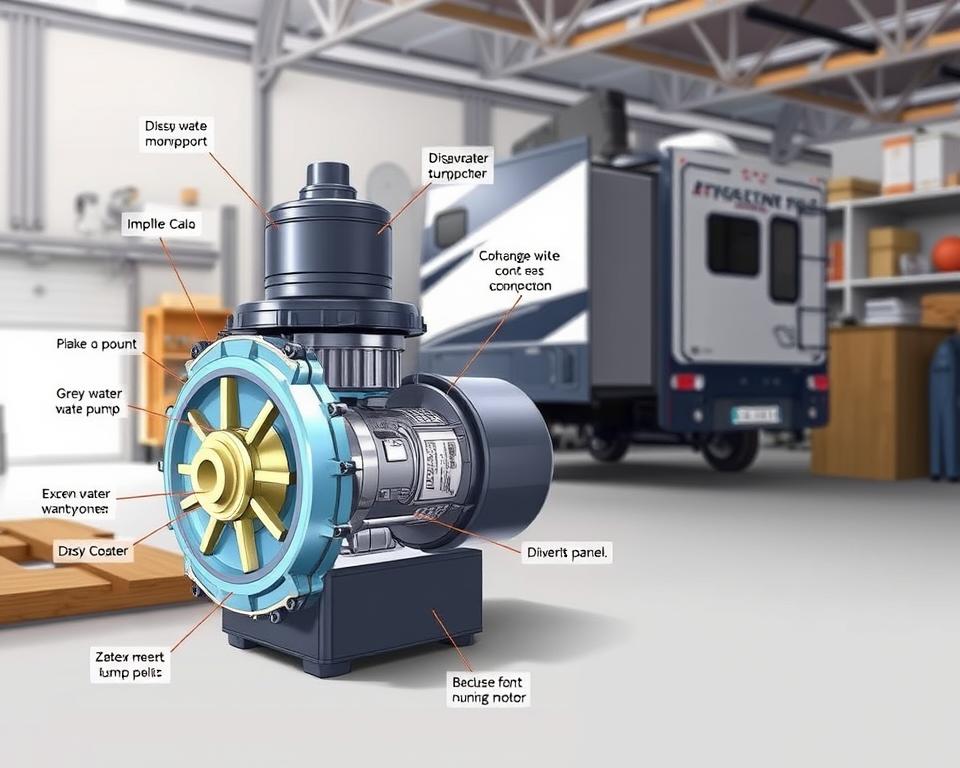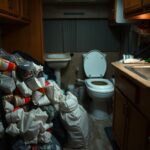Camper Water Tank & Pump: – Essential Manual
Eager to know the ingredient to easy roaming?? It’s all about your RV water Tank & Pump. Be it venturing into national parks or a quick weekend retreat, mastering your RV’s water system is vital. This article we dive into the basics: the elements, upkeep, and tips for worry-free travel. Knowing each element, from the pipework to reservoir filling, guarantees water is always at your disposal during your excursions – RV septic pumping near me.
Essential Highlights
- Understanding the RV fresh-water setup optimises your travel enjoyment.
- The RV water Tank and Pump are indispensable for a dependable water supply.
- Routine servicing extends the lifespan of your RV plumbing.
- Knowing how to fill your reservoir correctly can prevent future issues.
- Fixing your water Pump can save you from surprise problems.
Understanding RV Water Systems
RV water systems are split into two main parts: the potable-water setup and the grey/black-water mechanism. The clean-water circuit features several core components like the water Tank, pressure Pump, and faucets, echoing home plumbing yet tailored for the mobile needs of life on wheels.
Supplying safe water is paramount for the system’s reliability. It safeguards the safety of all passengers. It’s important to keep the RV plumbing in excellent order through scheduled maintenance – including proper drainage to prevent leaks and other faults. Timely inspections help RV enthusiasts sidestep water-related headaches during their journeys.

The Role of the RV Fresh-Water Tank
The RV fresh-water reservoir is key for a smooth journey. It stores the fresh water required for drinking, cooking, and cleaning. The capacity of this container varies with each RV model, impacting how much water can be stored – and has a direct bearing on how long you can roam before requiring a refill.
Ensuring the RV water Tank sanitary is essential. Periodic cleaning wards off harmful contaminants, ensuring water remains safe for use. Neglecting maintenance can promote bacteria or algae growth, making the water hazardous.
Recognising the RV water Tank’s role enhances water management on the road. Proper upkeep and frequent refills deliver a worry-free experience. It’s crucial to have ample water for all travel needs, guaranteeing a smooth RV adventure.
Filling Your RV Fresh-Water Tank
Refilling your RV water Tank calls for meticulous action to ensure it’s done correctly. There are two main methods: gravity-feed filling and city-pressure filling. Understanding these methods noticeably improves your RV water routine.
Gravity filling is simple. All you need a drink-safe water hose. Attach this hose to a water source, then to the fill opening, and allow gravity handle the fill. Always watch the water level to prevent spills.
Pressure filling relies on a city water connection, offering faster results. You need to use a pressure regulator to control water flow. Connect the hose from the municipal source to your RV. This method provides speedy and steady supply to your reservoir.
Choosing method you prefer, follow these key safety tips: Consistently monitor the fill when filling to prevent overflow, and use safe water to ward off health issues. Mastering these filling and safety techniques will make your RV trips even more enjoyable.
RV Water System: Parts in Focus
The RV Tank-and-Pump combo are vital to any RV’s plumbing system, delivering a steady and efficient water supply for all your needs. The RV water Pump’s main job is to move water from the reservoir, ensuring clean water is always on call. That’s vital for cooking, cleaning, and showering.
RV plumbing utilises different Pump types, each with individual benefits. Diaphragm pumps are prized for their even water pressure, while centrifugal pumps are prized for simplicity and energy thrift. It’s wise to weigh flow rate, noise, and installation ease when picking your Pump.
To sum up, the RV Tank-Pump pair are irreplaceable to your water system’s operation. A dependable Pump delivers strong pressure and smooth flow, enhancing your overall travel experience.
Choosing the Best-Fit RV Pump
Finding the correct RV water Pump is vital for your water system’s best performance. When shopping for a Pump, considering several points is critical for a satisfying camping experience. Ensuring it matches your RV’s water system is paramount.
Keep these primary aspects in mind:
- Flow Rate: Opt for a Pump with a flow rate that meets your usage needs. A higher flow means faster Tank refills.
- Pressure Ratings: Your RV’s multiple fixtures set the required pressure levels. Go with a Pump whose specs match those figures for smooth operation.
- Noise Levels: Noise can be an issue with some Pumps. For peace and quiet, compare models for their noise output.
Brands like SHURflo and VEVOR are favourites for many RVers, providing unique features. A detailed assessment of these brands will assist your decision-making process.
Understanding these factors is not only important for the proper purchase but also equips DIY tinkerers with essential know-how for upkeep and replacements.
Hooking Up to City Water for Your RV
Hooking your RV to city water provides an uninterrupted supply of fresh water, freeing you from just using your Tank. This delivers a more convenient camping experience. Be sure to follow specific steps for a successful hookup.
First, identify the city water connection port on your RV. It’s often marked by a bright or black connector, sometimes marked for ease. Grab a potable water hose rated for RVs; this type of hose protects your water safe from contaminants.
It’s critical to attach a pressure regulator before making the connection. This device protects your plumbing by controlling the water pressure. With the regulator in place, connect the hose from it to the water source.
Once connected, watch the water pressure. Aim for a steady, gentle flow to avoid hose damage. Inspect your hoses regularly for any wear or leaks and quickly replace parts as needed.
Adhering to these steps for city hookup boosts your camping convenience and aids in maintaining your RV’s condition.
Maintaining Your RV Water Tank
Keeping your RV’s water Tank is in good order is vital for fresh, healthy water while out on adventures. A sound Tank helps prevent bacterial growth and contamination. To begin, periodically sanitise the Tank: mix water with a bit of bleach for an effective residue-free clean.
It’s important to watch for leaks and control Tank pressure. Routine checks can spot problems early, sparing expensive fixes. A maintenance routine preserves the water system in excellent health.
To optimise maintenance, create a checklist:
- Check water levels and quality frequently.
- Sanitise the Tank twice a year with a bleach solution.
- Inspect for cracks in the reservoir.
- Monitor Tank pressure and Pump function.
- Flush the Tank to remove any sediment buildup.
RV Water Pump Diagnostics
RV water Pump issues can be frustrating, upending travel plans unexpectedly. Facing strange noises, experiencing low pressure, or suffering complete Pump failure are common problems. Understanding how to troubleshoot these issues can significantly enhance your trips.
Hearing odd sounds from your Pump is usually a problem. Start : check for loose connections and secure them. When there’s low water pressure, checking hoses and fittings for leaks. Even a small leak can dramatically affect flow, early troubleshooting is critical.
If your Pump quits completely, test electrical connections. Start with examining the Pump’s fuse. Should the fuse is fine, look further for wear or damage.
A step-by-step routine identifies and rectifies water system issues. Regular maintenance and inspection secure smoother journeys.
| Issue | Possible Cause | Suggested Solution |
|---|---|---|
| Strange Noises | Loose connections | Tighten fittings |
| Low Pressure | Leaky hoses/fittings | Find & seal leaks |
| Pump Failure | Electrical fault | Check fuse/wiring |
| No Water Flow | Blocked lines | Flush obstructions |
Hacks for Efficient RV Water Use
Travelling in off-grid areas usually means limited water access. Wise use in your RV is crucial. By embracing smart conservation tactics, you don’t just manage resources well but also heighten camping satisfaction.
To squeeze every drop of water while travelling, consider these tips:
- Take brief showers – aim for under five minutes.
- Install water-saving fixtures like low-flow showerheads and faucets.
- Reuse grey water: dishwater can flush toilets or water plants.
- Monitor reservoir levels regularly to avoid overflow.
- Plan water stops in advance: know filling stations along your route.
The Bottom Line
Mastering the intricacies of your RV water systems is central to a fulfilling travel adventure. The Tank and Pump remain at the core of this, needing consistent upkeep. By looking after these systems, you secure a dependable supply and sidestep potential snags.
Consistent troubleshooting and checks limit stress and save time. Being proactive about upkeep is crucial, especially when you’re miles away from help. Proper care allows you to maximise water use, raising comfort for everyone.
On your next outing, keep this guide to tame your RV’s water systems. Making informed choices about plumbing and equipment equip you to enjoy the freedom of the road. Enjoy happy and trouble-free travels ahead!

